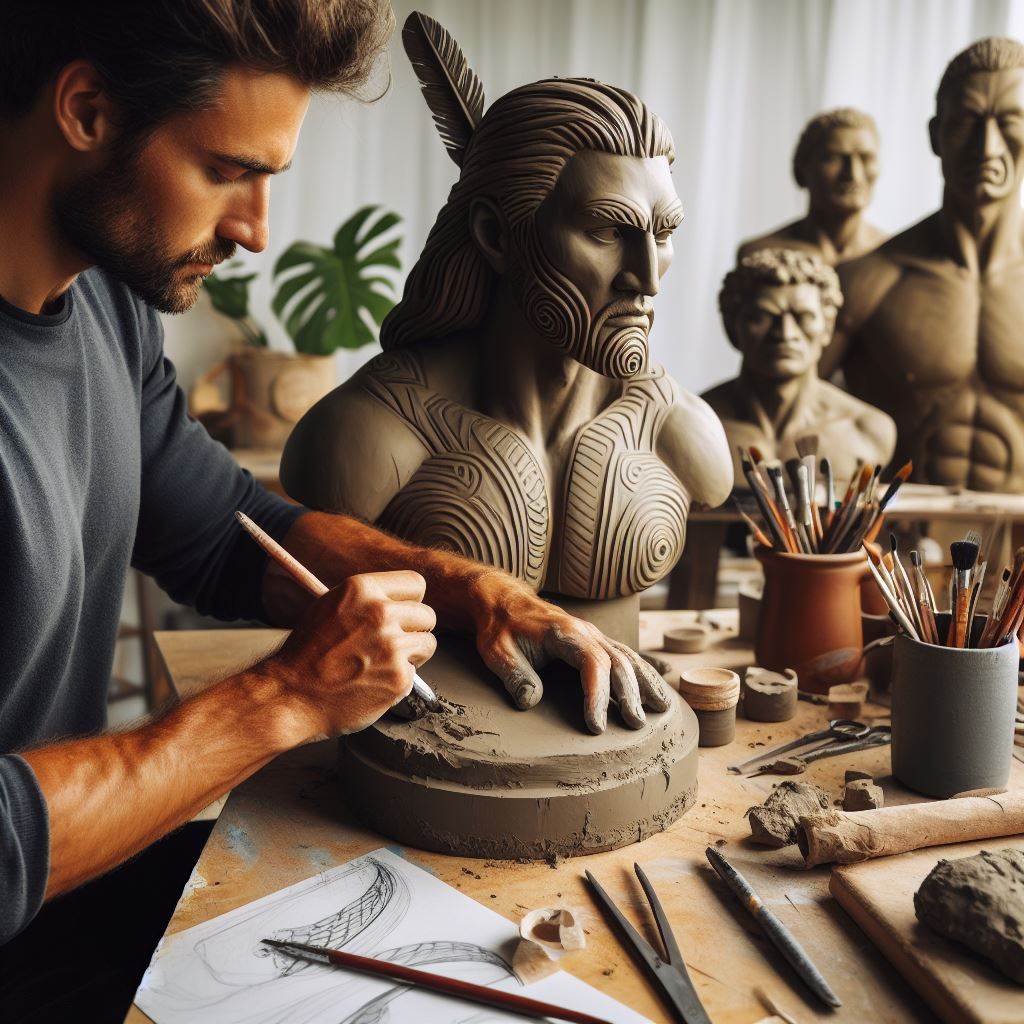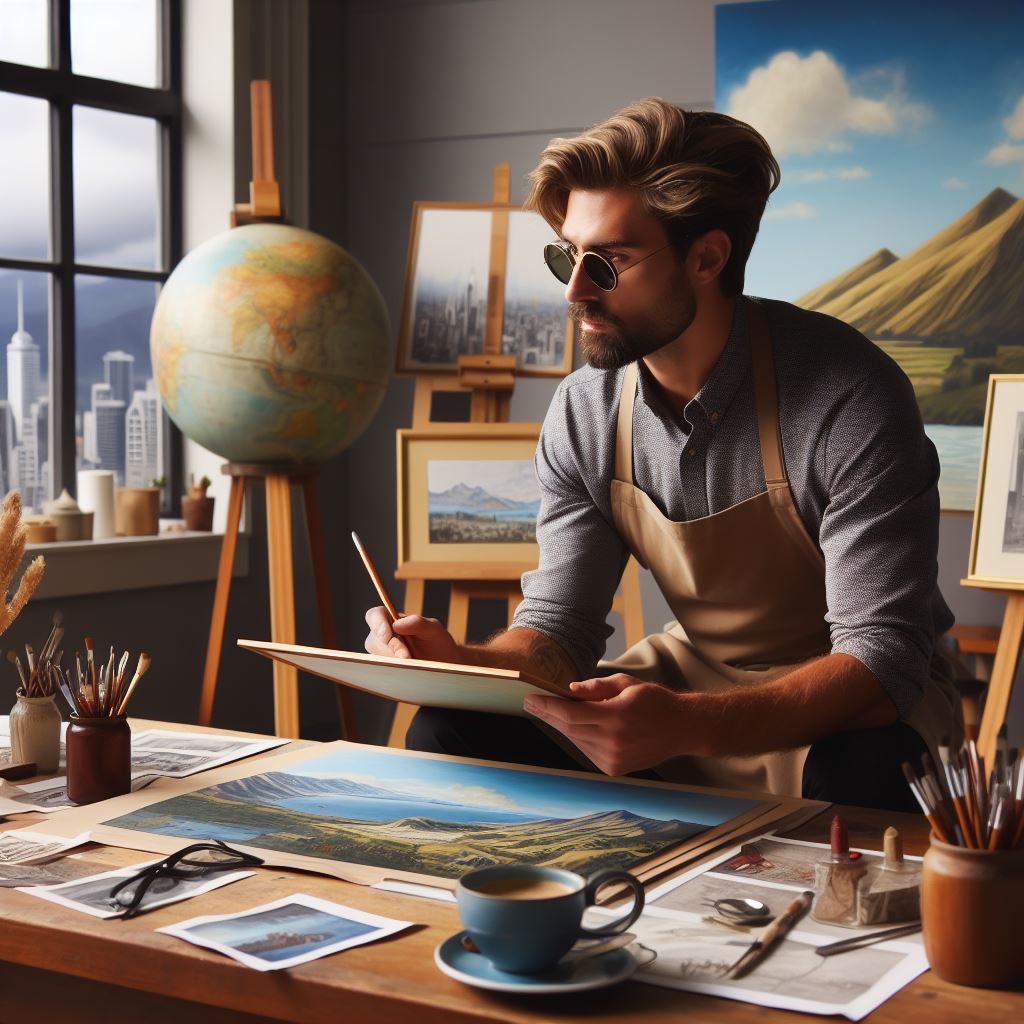Introduction
Sculpting in NZ offers a world of creativity and opportunity for artists. The importance of honing skills and acquiring knowledge cannot be underestimated in this field.
Notably, New Zealand boasts a diverse market for sculptors, ensuring a wide range of potential clients and buyers.
In the scenic landscapes of New Zealand, sculpting has become a prominent art form. Artists use various materials and techniques to create exquisite sculptures that showcase their skills and creativity.
The ability to sculpt and shape raw materials into stunning works of art requires extensive knowledge and practice.
Furthermore, skills and mastery in sculpting are essential for artists to stand out in an ever-competitive market.
In New Zealand, sculptors need to constantly refine their craft and stay updated with the latest trends and techniques to remain relevant and sought after.
This emphasis on skill development and knowledge ensures that artists continue to produce exceptional sculptures that captivate audiences.
The market for sculptors in New Zealand is remarkably diverse. From public art installations to private commissions, there are numerous opportunities for sculptors to display their talent and earn a living.
Sculptures can be found in galleries, museums, parks, and even corporate spaces, offering a wide range of potential clients and buyers.
In addition, New Zealand’s rich cultural heritage and strong connection to nature provide inspiration for sculptors, which further contributes to the demand for their work.
Artists can explore themes such as Maori mythology, environmental conservation, and personal expressions, catering to the diverse preferences of the market.
The importance of skills and knowledge in the field
In essence, sculpting in New Zealand offers a fulfilling and dynamic career path for artists.
The importance of skills and knowledge cannot be underestimated, and the diverse market ensures that sculptors have ample opportunities to showcase their talent and find success.
As sculpting continues to thrive in New Zealand, the future looks promising for both established and aspiring artists in this field.
Skills Required for Sculpting
Foundational Skills
Sculpting requires various foundational skills, including drawing, modeling, and understanding anatomy. These skills form the basis of a successful sculptor’s practice.
Creativity and Artistic Vision
Beyond technical expertise, sculpting demands creativity and artistic vision. Sculptors need to breathe life into their creations and express their unique perspectives through their work.
Technical Skills
Sculpting also requires a range of technical skills. Sculptors must have knowledge of different materials, tools, and techniques to bring their artistic ideas into physical form.
Drawing
A sculptor’s ability to draw helps them sketch and plan their sculptures before diving into the physical process. Drawing allows them to refine their ideas and visualize the final outcome.
Modeling
Sculptors use modeling techniques to shape and mold their chosen materials, be it clay, stone, or metal. Modeling skills enable them to create 3D representations of their concepts.
Understanding Anatomy
Knowledge of anatomy is crucial for sculptors to accurately depict human or animal forms. It helps them capture realistic proportions, muscle structures, and gestures in their sculptures.
Creativity
Sculpting is a form of art, and creativity is at its core. Sculptors must have the ability to think outside the box, explore unconventional ideas, and push boundaries to create unique and captivating sculptures.
Artistic Vision
Having a clear artistic vision allows sculptors to imbue their sculptures with meaning and evoke emotions. It helps them communicate their intended message to viewers through their work.
Knowledge of Materials
Sculptors should have a deep understanding of different materials and their properties. This knowledge helps them select the most suitable material for their sculpture and use it effectively.
Personalized Career Consulting
Unlock your potential with expert career advice tailored to your goals. Get personalized guidance and actionable steps toward your dream career in New Zealand.
Get StartedFamiliarity with Tools
Sculptors must be proficient in using various tools specific to their chosen material.
Whether it’s chisels, brushes, or welding equipment, knowing how to handle these tools is essential for achieving desired results.
Technique Mastery
Sculptors should continuously refine their skills and experiment with different techniques.
Whether it’s carving, casting, or modeling, mastering these techniques allows for more expressive and technically proficient sculptures.
Patience and Persistence
Sculpting is a time-consuming process that often involves overcoming challenges. Sculptors need patience and persistence to work through setbacks, refine their sculptures, and achieve their desired outcome.
Attention to Detail
Sculptors must pay close attention to detail to capture the intricacies of their subject matter.
Whether it’s replicating textures or sculpting intricate facial features, meticulousness is crucial for creating lifelike sculptures.
Problem-solving
Sculpting often presents unexpected difficulties that require problem-solving skills. Sculptors must be able to adapt to challenges, find creative solutions, and make adjustments throughout the sculpting process.
Continuous Learning
Sculptors should have a thirst for knowledge and a dedication to continuous learning.
Keeping up with new techniques, materials, and trends ensures their artistic growth and relevance in a changing market.
In general, sculpting is a multidimensional art form that demands a combination of foundational skills, technical expertise, creativity, and artistic vision.
Successful sculptors hone their skills over time, continuously pushing the boundaries of their craft and adapting to evolving markets.
Read: Maori Music: NZ’s Rich Heritage
Education and Training Opportunities
When it comes to pursuing a career in sculpting, New Zealand offers various educational paths and institutions to nurture aspiring sculptors.
These opportunities are crucial for individuals looking to hone their skills and establish themselves in the industry.
Different Educational Paths and Institutions
Several institutions in New Zealand provide sculpting programs that cater to different levels of expertise.
These institutions offer a range of courses that focus on various aspects of sculpting, including traditional techniques and contemporary practices.
- University of Auckland: The Elam School of Fine Arts at the University of Auckland is renowned for its comprehensive art programs, providing aspiring sculptors with a well-rounded education.
- Whitireia New Zealand: This institution is known for its strong vocational focus, offering practical sculpting programs that equip students with the necessary skills to succeed in the industry.
- Toi Whakaari: The New Zealand Drama School also offers specialized courses in prop-making and theatrical sculpting, allowing students to explore sculptural art in a dynamic context.
Specialized Courses and Workshops
In addition to formal educational programs, there are a variety of specialized courses and workshops available for sculptors of all levels.
These opportunities allow artists to further develop their skillset and explore new techniques.
- Stone Sculpture Workshops: Various institutions and independent artists offer workshops focused on stone sculpting, allowing participants to learn the art of carving unique creations.
- Metal Sculpture Courses: For those interested in working with metal, specialized courses provide insights into welding, metal shaping, and construction techniques.
- Contemporary Sculpting Workshops: These workshops provide a platform for artists to experiment with unconventional materials and explore contemporary sculpting practices.
The Benefits of Formal Education and Training
Pursuing formal education and training in sculpting offers numerous benefits to aspiring artists.
- Technical Skills: Educational programs expose students to various techniques, helping them develop a strong foundation in sculpting methods and materials.
- Networking Opportunities: Institutions and workshops provide valuable networking opportunities, allowing sculptors to connect with peers, mentors, and industry professionals.
- Critical Feedback: Formal education platforms offer feedback and critique sessions, enabling sculptors to gain insights from experienced instructors and improve their work.
- Exposure to Diverse Perspectives: Educational environments allow artists to interact with students from diverse backgrounds, fostering collaboration and expanding artistic horizons.
- Portfolio Development: Education and training programs assist sculptors in building a strong portfolio, which is crucial for showcasing their skills and securing future opportunities.
Basically, New Zealand presents abundant education and training opportunities for aspiring sculptors.
From formal educational institutions to specialized workshops, artists have various paths to choose from to develop their sculpting skills and flourish in the industry.
Read: NZ Music Festivals: Behind Scenes
Transform Your Career with a Professional CV and Cover Letter
Stand out to employers with an ATS-optimized resume and tailored cover letter designed to match your dream role. Let us craft your job application materials for success!
Get StartedSculpting Markets in NZ
The demand for sculptures in New Zealand is thriving across various sectors. From public art installations to private commissions and galleries, sculptures have established a significant presence.
The public art sector in New Zealand actively seeks out sculptures for urban landscapes and community spaces.
Local councils and government organizations often commission sculptures to enhance public areas and contribute to the cultural identity of a place.
Private commissions are another avenue through which sculptors find opportunities.
Individuals, businesses, and organizations often seek unique and personalized sculptures as a way to express their values, commemorate events, or adorn their properties.
Galleries play a crucial role in promoting sculptures and connecting artists with potential buyers.
These art spaces provide a platform for sculptors to showcase their work and reach a wider audience.
They act as intermediaries between artists and collectors, facilitating sales and fostering relationships.
The growing market for sculptures in interior design and architecture
There is a growing market for sculptures within interior design and architecture industries in New Zealand.
Sculptures are increasingly seen as integral elements of interior spaces, adding aesthetic appeal and a sense of artistic expression.
Designers and architects now incorporate sculptures as focal points, enhancing the overall ambiance of a space.
The New Zealand government recognizes the significance of the sculpting industry and supports sculptors through various initiatives and funding programs.
These initiatives aim to provide financial assistance, professional development opportunities, and visibility for sculptors.
Government initiatives or funding programs supporting sculptors in NZ
One such government initiative is the Creative New Zealand Arts Grants.
This funding program offers grants to individual artists, including sculptors, to help with creative projects, research, and professional development.
It enables sculptors to pursue their artistic endeavors and expand their skills.
The New Zealand Sculpture OnShore, a prominent biennial sculpture exhibition, is another government-supported initiative.
This event showcases the works of both established and emerging sculptors, providing them with a platform to exhibit and sell their sculptures.
The exhibition also raises funds to support Women’s Refuge New Zealand.
Moreover, the Wellington Sculpture Trust is a partnership between the Wellington City Council and the local community, dedicated to the development and promotion of sculptures.
The trust manages sculpture projects in public spaces and assists sculptors in collaborating with the community.
Essentially, the demand for sculptures in New Zealand is diverse and encompasses sectors such as public art, private commissions, galleries, interior design, and architecture.
The government recognizes the importance of supporting sculptors and has implemented various initiatives and funding programs to foster their growth and success in the industry.
Read: Women in NZ Music: Rising Stars

Successful Sculptors in NZ
When it comes to sculpting in New Zealand, there are several artists who have achieved great success in the field.
These sculptors have their own unique styles, and their journey to success is an inspiration to many aspiring artists. Let’s take a closer look at some of these successful sculptors in NZ:
Dame Louise Henderson
- Known for her abstract sculptures, Dame Louise Henderson is one of the most influential sculptors in NZ.
- Her journey to success started in the 1940s when she began experimenting with different materials and techniques.
- Dame Louise Henderson has received numerous awards and recognition for her contributions to the art world.
- One of her notable public installations is the ‘City to the Sea Bridge’ in Wellington, which showcases her unique style.
Chris Booth
- Chris Booth is a renowned sculptor known for his large-scale installations that blend seamlessly with the natural environment.
- His journey to success started in the 1970s when he began creating sculptures inspired by the landscapes of NZ.
- Chris Booth has received several awards for his work, including the prestigious Wallace Arts Trust Paramount Award.
- One of his notable projects is the ‘Waitakaruru Arboretum Sculpture Park’ in Hamilton, which features his unique style and vision.
Neil Dawson
- Neil Dawson is a highly regarded sculptor known for his large-scale public installations and kinetic sculptures.
- His journey to success began in the 1980s when he started creating sculptures that challenge traditional notions of space and form.
- Neil Dawson has received international acclaim for his work, including the Laureate Award from the Arts Foundation of New Zealand.
- One of his notable public installations is the ‘Ferns’ in Wellington, which features his signature style of suspended geometric forms.
Jeff Thomson
- Jeff Thomson is a unique sculptor who specializes in creating artworks using corrugated iron.
- His journey to success began in the 1990s when he started exploring the aesthetic potential of this unconventional material.
- Jeff Thomson has been recognized for his innovative approach and has exhibited his artworks in both NZ and overseas.
- One of his notable public installations is the ‘Flora on the Hill’ in Christchurch, which showcases his mastery of corrugated iron sculptures.
These successful sculptors in NZ have not only made a significant impact in the art world but also contributed to the cultural landscape of the country.
Their unique styles and dedication to their craft have earned them respect and admiration from both fellow artists and art enthusiasts.
Through their journey to success, they have overcome challenges and pushed the boundaries of what is possible in sculpting.
Their awards, recognition, and notable public installations serve as a testament to their talent and hard work.
Boost Your Career with a Standout LinkedIn Profile
Attract recruiters and expand your network with a fully optimized LinkedIn profile tailored to highlight your strengths and professional goals. Let your profile open doors to new opportunities!
Get OptimizedAspiring sculptors in NZ can draw inspiration from these successful artists and strive to carve their own path in the world of sculpting.
With determination, passion, and a unique artistic voice, they too can achieve greatness and leave their mark on the art scene in New Zealand.
Read: Grants for NZ Musicians: A Guide
Challenges and Opportunities for Sculptors
Being a sculptor in New Zealand comes with its fair share of challenges and opportunities.
In this section, we will discuss the financial challenges faced by sculptors and the importance of networking and marketing skills.
We will also explore the potential opportunities for collaboration with other artists or professionals in related fields, as well as the importance of staying updated with industry trends and continuously honing skills.
Financial Challenges
- Sculptors often struggle with the financial aspect of their craft, as it can be difficult to secure consistent income.
- The demand for sculptures varies, and sculptors might face periods of lull where they don’t have commissioned projects.
- Materials and equipment required for sculpting can be expensive, adding to the financial burden.
- Establishing a reputation and finding a market for their work takes time and effort.
To overcome these challenges, sculptors need to develop strong networking and marketing skills.
Networking and Marketing Skills
- Sculptors must actively participate in the art community, attending events, exhibitions, and workshops to network with other artists and potential clients.
- Building relationships with galleries and art dealers can help increase exposure and sales opportunities for sculptors.
- Utilizing social media platforms and creating an online portfolio can attract a wider audience and potential buyers.
- Effective communication and negotiation skills are crucial in securing commissions and collaborations.
Collaboration
Sculptors have the opportunity to collaborate with other artists or professionals in related fields, which can lead to exciting new projects and expanded artistic horizons.
- Collaborating with architects or interior designers can result in sculptural installations in public spaces or commercial buildings.
- Joining forces with other sculptors can lead to joint exhibitions, where their works can complement and enhance each other.
- Working with craftsmen, such as metalworkers or woodworkers, can bring new dimensions to a sculptor’s work.
- Collaborating with writers or poets can result in the integration of sculpture and storytelling.
Staying Updated and Honing Skills
To thrive in the competitive world of sculpting, artists need to continually update their skills and knowledge.
- Attending workshops, classes, and conferences can provide sculptors with valuable insights into new techniques and technologies.
- Keeping an eye on industry trends and contemporary art movements can inspire fresh ideas and keep their work relevant.
- Experimenting with different materials or exploring unconventional approaches can push boundaries and lead to innovative creations.
- Investing time in artistic development and self-reflection is essential for sculptors to evolve and grow as artists.
Ultimately, sculptors in New Zealand face financial challenges but have various opportunities to overcome them and thrive in their craft.
Networking, marketing, collaboration, and continuous skill development are vital components of a successful sculpting career.
Conclusion
In closing, skills and knowledge play a significant role in sculpting in NZ. Sculptors need to have a deep understanding of various techniques, materials, and processes.
Without the right skills, it can be challenging to create high-quality sculptures that resonate with the viewers.
Furthermore, the diverse market and opportunities available for sculptors in NZ are worth mentioning.
There is a growing appreciation for sculpture in the art scene, with various galleries, art festivals, and exhibitions showcasing sculptural works.
This presents a favorable environment for sculptors to showcase their talent and gain recognition.
To aspiring sculptors, I encourage you to pursue your passion and explore the thriving sculpting scene in New Zealand.
With dedication and continuous learning, you can develop your skills and create remarkable sculptures that leave a lasting impact.
Don’t be afraid to experiment with different styles and techniques, as this will help you find your unique voice in sculpting.
Ultimately, sculpting in NZ is an exciting and rewarding journey. The combination of skills, knowledge, and the vibrant market creates a fertile ground for sculptors to thrive.
Whether you are a beginner or an experienced artist, take advantage of the available resources, art communities, and mentorships.
Embrace the challenges, push your creative boundaries, and let your sculptures tell stories that resonate with the world.
Start your sculpting journey today and contribute to the ever-evolving art landscape of New Zealand.




